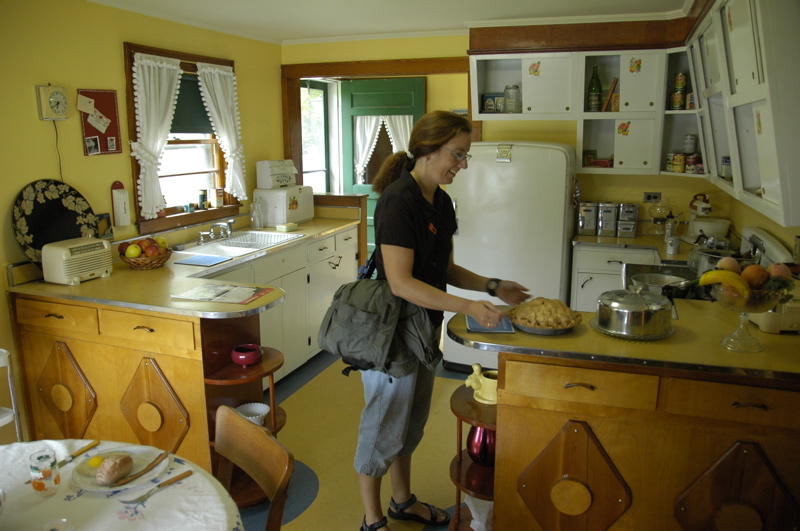Being in our former “back yard” we already know the interesting local attractions to visit, but like a lot of people we don’t often visit them. But with a rainy forecast again today, Eleanor and I decided to take the day at the local Shelburne Museum. The Museum has 39 buildings housing an incredible array of exhibits, so even on a rainy day it’s a great place to go.
The trick to visiting the Museum is to pace yourself. It’s not the usual sort of in-and-out place. With 37 buildings spread over 45 acres, and 150,000 objects on exhibit, there is no way you’ll see it all.
Think about that: 150,000 things to see. If you view an object every ten seconds and don’t stop to sleep or go to the bathroom, it will take eighteen days to see it all. If you zip through an entire building full of exhibits in 30 minutes, you’ll need most of three days to see them all. Even with the standard two-day ticket ($18 for adults, $9 for Vermont adults with I.D.) you have to accept that you’ll only be able to appreciate a tiny fraction of the Shelburne Museum.
I used to go to the Museum every year in grade school, and many times since. It never gets boring. I still see things I have never seen before. But knowing most of the buildings intimately, Eleanor and I decided to focus on the places we like the most. The first stop for us is usually the “1950 House,” pictured above. It’s a remarkably simple concept: take a real house that borders the museum and fill it with all the furniture, clothing, food, and appliances that it would have had back in 1950. Everyone loves it.
We also like the Kalkin House, the General Store and Apothecary Shop, the Ticonderoga paddlewheel steamship, the Variety Unit (with a fascinating collection of automatons, among other things) and many other places. The Shelburne Museum collects “Americana,” essentially almost anything from American life that can be collected. You can get lost in some of the collections, just browsing and fantasizing about being back in days of the 18th or 19th century.
The Apothecary got our attention for its huge collection of antique patent medicines. Most of them cured problems we never heard of. When was the last time you had scrofula, King’s Evil, salt rheum, neuralgia, biliousness, dropsy, or liver complaint? Apparently a good dose of sarsaparilla can fix all that. Or you can take “Kodol” for sick headache, flatulence and “water brash.” The 12% grain alcohol content in Kodol is supposedly added only to prevent the ingredients from fermenting. With that much alcohol in it, who needs more fermentation?
 The special exhibits are always a treat. Today they were running an exhibit of marvelously carved carousel animals, including exotic African beasts like lions and giraffes. Do you know why modern carousels feature only horses? Apparently the carousel owners noticed that children were frightened of them, and mostly rode the horses.
The special exhibits are always a treat. Today they were running an exhibit of marvelously carved carousel animals, including exotic African beasts like lions and giraffes. Do you know why modern carousels feature only horses? Apparently the carousel owners noticed that children were frightened of them, and mostly rode the horses.
![]() Another fascinating thing about the Museum is that only one of the buildings on the grounds was originally there. The rest were generally dismantled stick-by-stick (or in many cases, brick-by-brick), transported to the site, and re-assembled exactly as they were. That includes a lighthouse that formerly sat on Colchester Reef in Lake Champlain, including the large stones it sat on, and a completely intact steamship called the S.S. Ticonderoga. (The Ticonderoga was hauled from the lake via a specially-constructed rail line.) For that reason alone I am always compelled by the diverse architecture.
Another fascinating thing about the Museum is that only one of the buildings on the grounds was originally there. The rest were generally dismantled stick-by-stick (or in many cases, brick-by-brick), transported to the site, and re-assembled exactly as they were. That includes a lighthouse that formerly sat on Colchester Reef in Lake Champlain, including the large stones it sat on, and a completely intact steamship called the S.S. Ticonderoga. (The Ticonderoga was hauled from the lake via a specially-constructed rail line.) For that reason alone I am always compelled by the diverse architecture.
The late afternoon thunderstorms arrived on schedule, but that’s OK because we were aboard the “Ti” when the worst of the rain hit. Besides, the Museum closes at 5 pm most days and we were beginning to suffer overload. We have our receipt and may go back again on Sunday just to browse a few more buildings. I think we’ve only seen about 30,000 items so far.




